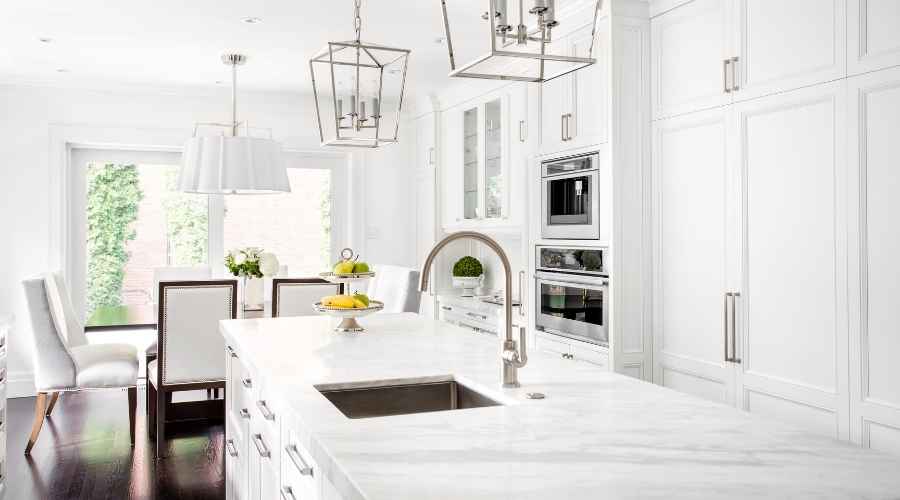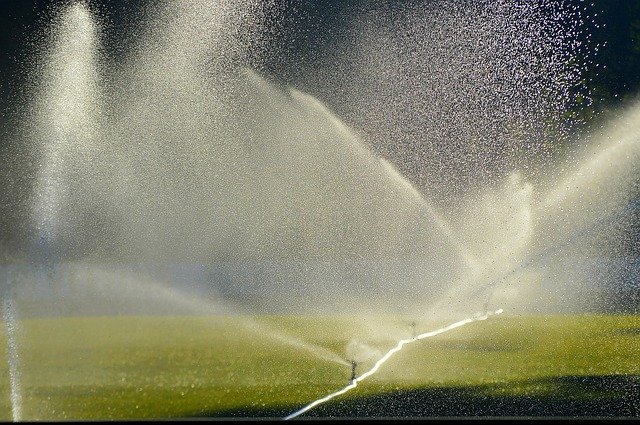- Damp-Looking Stucco – It shouldn’t be concerning if the stucco sometimes gets damp. The fact that it’s wet will make sense when it has rained. It nonetheless indicates that water has penetrated the stucco if it is still damp a week after the rainy weather. There might be areas of the wall that constantly seem moist. Pay special attention to them since water may be entering there.
- Cracks – An obvious indication that there is water in your stucco is a crack in it. Though it doesn’t necessarily mean that you have sustained permanent harm, you shouldn’t panic. You must act right away to prevent things from getting worse because it is a sign that water has entered the building.
- Missing Chunks of Stucco – Examine your stucco to check for any siding pieces that may have peeled off. Surface damage indicates that water has seeped underneath and is causing issues.
- Cracks and Bubbles at the Bottom of the Wall- Check the bottom edges for any obvious cracks or bubbles during your inspection. Water must follow gravity’s laws, just like everything else, or it will fall. Therefore, the majority of the damage may be located at the wall’s base.
- Window Caulking Damage – Do you see any cracks or holes in your window caulking? Additionally, it indicates that water has penetrated the stucco. You will also need to replace those windows if it has been there for a significant amount of time. Regular stucco inspections are crucial because of this.
- Soft Drywall – You’re heading inside to carry out your probe. Examine the drywall below your windows. When you touch it, does it feel soft? Another clear indication of water damage is that. In these situations, the outside stucco and that part of the drywall will need to be replaced.
- Basement Moisture- And lastly, check the walls in your basement. You’ll observe that if the stucco contains water, it may result in moisture on the walls. However, since there are other potential causes, you should eliminate them before fixing the issue.
Beginner’s Guide to Radiator Placement
Are you getting ready to buy a new radiator? Well, it does matter where you put your new radiator. If you put it in the wrong place, you’ll end up with a heating system that doesn’t work well and will cost you a lot of money over time.
Want to know everything there is to know about where to put radiators? In this article, we’ll talk about where you should and shouldn’t put your radiator so you can get the most out of it.
What You Need to Know About Putting in a Radiator
You don’t know where to put your radiator. Here are some general tips and warnings about radiators to help you make the best choice.
Put a window under your radiator.
Do cold drafts often come into your house? If that’s the case, you might want to put your radiator under a window. This will stop any cold air from coming in through the window and spread the heat evenly throughout the room.
This placement works best if you live in a house with single-glazed windows, which let in cold drafts more easily. If you have better insulation and double-paned windows, you might not need this placement.
Place your radiator on a wall that faces north.
Did you know that walls that face north usually get less sun and are therefore colder? Because of this, you might want to put your radiator on the inside of a wall like this. This will stop cold air from moving around the room, and it will work better than putting a wall on the east side of the room, which is already warm from the sun.
Don’t put furniture near your radiator.
If you don’t like the way a radiator looks, you might be tempted to try to hide it behind a sofa or other piece of furniture. This will only stop your radiator from working at its best and spreading heat. Doing this could also trick the thermostat in your room into thinking that the room is at the right temperature, which would cause it to turn off, which would be useless.
You also shouldn’t put a radiator cabinet behind your radiator. This may seem like a good idea, but in the end, it will block a lot of heat, which will cost you more money and give you less heat.
There are many sleek and modern radiators on the market today, so if you don’t like the one you’re looking at, keep looking until you find one that fits your space.
Don’t put your curtains near your radiator.
Not putting your radiator next to your curtains is another important thing to avoid. If you do this, you will end up pushing out the window instead of into the room, and the radiator’s power will be used up.
If the radiator shorts out next to the curtains, you could have safety problems.
Final Thoughts on Where to Put the Radiator
When it comes to heating your home, where you put your radiators makes all the difference in how much heat and energy you use. By following the tips and tricks in this article about where to put your radiator, you can find the best spot for it.
No matter where you put your radiator, you need to make sure it gets regular maintenance to make sure everything is working right. Here are some tips for taking care of your radiator.
Why Choose Stucco for Your Home’s Exterior
If your home’s exterior might use an improvement, stucco is an excellent option, since this material will alter your property and dramatically enhance its outer appearance. Stucco is a blend of cement adhesive, sand or marble stones, pigment, and water, and is ideal for those seeking a contemporary home finish.
There are numerous advantages to this material, and the following characteristics explain why you should pick stucco for the exterior of your home:
Durability
This cement combination is so resilient that it can endure up to 50 years with minimal maintenance. Stucco expands and contracts with the weather, so there is no need to worry about cracking, and this material will not deteriorate under the pressure of the changing seasons. If your contractor properly waterproofs the exterior of your stucco, the material will also be resistant to mildew, mold, and damage.
Maintenance
Stucco requires minimal care because it does not need to be painted or reapplied frequently. Compared to other materials, stucco does not require frequent replacement or cleaning, so you may enjoy these benefits as a homeowner and not worry about your home’s façade. If you believe that your stucco appears dirty, you can easily wash the walls with a pressure washer, and if you desire a change, you can paint the stucco.
Value
Adding stucco to the exterior of your home might boost its worth since potential buyers will take note of this feature. As a result of stucco’s energy efficiency, fire resistance, rot resistance, and low maintenance, the value of your property will increase substantially. Stucco offers sound-dampening properties and will boost your home’s curb appeal, making it an excellent choice. If you decide to sell your property, this material will increase its worth, and if you decide to stay, you can apply for lower homeowner’s insurance premiums.
Simple Installation
This procedure is relatively straightforward, and stucco installation takes approximately two days to finish. This consists of drying time, therefore the process is quick. Moreover, stucco is a versatile material because it can be applied to a variety of substrates, including wood and stone. Once the stucco has been installed, you can choose the color; this is an enjoyable process, so consider your tastes. Keep in mind that, unlike brick, stucco would allow you to change the color of your stucco at any time.
The professionals at CMB Stucco & EIFS Repair Edison can provide additional information on this material. We can assist with stucco repairs and help alter your property, so call us today for more information!
The Best Way To Protect Your Investment Is To Coat The Asphalt
Asphalt coating is one of the services that most people don’t use when they hire a paving company. It’s an extra cost that most commercial property owners don’t want to pay on top of what it costs to pave a lot. It makes sense since a new asphalt parking lot can cost a lot of money. But to protect that investment, you need to take good care of the lot over time. One of the most cost-effective ways to do that is to have an asphalt coating put on the lot.
How an Asphalt Coating Can Help Secure Your Parking Lot
A lot of things can be done with an asphalt coating, which is also called a sealcoat or a parking lot sealer. First of all, an asphalt coating adds another layer of protection to your lot against wear and tear. Sealcoating makes a barrier that water can’t get through. This keeps water from getting into the surface and causing damage to your asphalt lot. This keeps the water from freezing in cold weather and leaving cracks when it warms up.
Every time it freezes and thaws, these cracks, which are often hard to see at first, will get bigger. If these cracks aren’t fixed, they can get big enough to turn into potholes. A parking lot with a lot of potholes is not only ugly, but it is also dangerous. The cost of fixing potholes goes up the more and the bigger they are, but an asphalt coating can stop them from happening in the first place.
Your New Asphalt Can Last Longer
Asphalt is a fairly strong material for roads. Still, even the best-paved parking lots will wear down over time because they are always open to the weather. Putting an asphalt coating on your lot can protect it from these things for an extra three to five years. This makes your lot last longer.
This does more than just stop cracks from appearing, though. An asphalt coating will protect your parking lot for a long time and make it look like it was just paved. Seal coats protect asphalt from the sun’s UV rays, which keeps it from turning from shiny black to a dull, lifeless gray. This makes your commercial property look better from the street, which can help you get more business.
What You Need to Know About Asphalt Coating
It’s true that your parking lot might not need an asphalt sealcoat, but that’s just the truth. At the same time, though, a sealcoat is so good at protecting your newly paved lot that it would be a bad idea not to have one put on. The truth is that if you don’t sealcoat your lot, you’ll have to spend a lot more money on upkeep than you would if you did.
Investing in an asphalt coating is the best thing you can do to save money on overall maintenance costs, extend the life of your lot, and make sure your commercial property looks great for years to come.
Maintenance Tips for Asphalt & Concrete in the Spring
Ah, the first indications that spring has arrived. Birds of the Robin family looking for worms in the backyard. There are pansies available for purchase at the garden centers. The driveway is beginning to show signs of cracking. Not all harbingers of spring are ones that are eagerly anticipated. Asphalt and concrete both suffer damage when the winter’s wear and strain are combined with the spring thaw. Even while a well-laid surface should be worry-free, it will still require occasional maintenance to ensure that it remains healthy and appealing.
The month of March is getting closer by the day, and with it comes rising temperatures during the day with more sun beating down on the asphalt and concrete driveways, which leads to expansion within, and then with the still cold temperatures during the overnight hours, you have a contraction. March is getting closer by the day.
Throughout the winter months, snow and ice will continually freeze and thaw on the asphalt surfaces of your property. The freeze-thaw cycle can cause water to pool and infiltrate into your asphalt surface if your asphalt has uneven parts or if it isn’t graded appropriately. This can happen if your asphalt has uneven areas. Because of the way that water behaves when it freezes, your asphalt will break as a result. These cycles of freezing and thawing can cause homeowners and property owners to deal with issues such as potholes and cracks in their driveways and lots. Some of the factors that can contribute to this issue include moisture, plowing practices, the material itself, and the layout of the driveway or lot.
It’s possible that your driveway could use some work if it’s full of low spots, made of moisture-retaining soil, or surrounded by raised land. Having a crown in your driveway means that it should have a slightly higher place in the center, sloping to either side so that water drains off when it melts or falls instead of pooling up. This will prevent water from becoming a hazard. It is important that water be able to flow away from the driveway and into lower areas on either side, sometimes even into road ditches.
The beginning of spring is the time of year when asphalt pavements are most susceptible to deterioration. The water that is contained within the pavement and aggregate base freezes over the winter, beginning at the top of the pavement and extending all the way down to the subgrade. The spring thaw is the process in which the frozen pavement gradually thaws from the surface of the pavement all the way down to the subgrade. Because the subgrade is frozen, water that has been released from the melting pavement is prevented from escaping into the materials that lie beneath the pavement. his sub-grade, after having been saturated by the, might become much weaker, allowing the pavement to be readily damaged by automobile traffic loads.
The question now is, how can I safeguard my investment and/or my driveway? Protecting your pavement should begin with preventative maintenance as a good first step. The majority of the water will be prevented from reaching the sub-grade if cracks and potholes are sealed and filled. Examine the layout of your home, specifically the driveway. Find out where all of that water is going, as well as where it is coming from, and report back. Is it making its way to a storm drain through the cracks in the pavement? Because asphalt pavements have a natural aversion to water, it is important to ensure that the drainage surrounding your snow heaps is adequate so that the water can be removed from the pavement as quickly as possible.
Consider the following important aspects of the situation:
- Asphalt is naturally porous, which means that it is capable of taking in water from its surrounding environment. When water seeps into asphalt during the winter, the water has the potential to expand and freeze beneath the surface of the pavement. This can lead to cracks and other issues. The more cracks that form in your driveway, the more water it will be able to absorb, which will ultimately lead to additional cracking and deterioration of the asphalt. These issues can severely cut down on the amount of time your driveway is useful for its intended purpose.
- Because of the persistent presence of ice and snow during the winter, asphalt can suffer significant damage from the season.
- Cracks in a driveway can be caused by a wide variety of factors, including excessive weight, the presence of underground tree roots, movement in the soil, and, of course, excessively cold weather. Because it is porous, concrete can be penetrated by precipitation such as rain or snow, which will then swell when it freezes and shrink when the temperature rises above freezing. A driveway may develop cracks, deterioration, and even flaking as a result of the repeated expansion and contraction that occurs over the fall and winter months.
- On concrete, you should steer clear of de-icers that contain ammonium sulfate, magnesium acetate, and ammonium nitrate since they might cause the surface to deteriorate. The same rule ought to be followed with regard to lawn chemicals, which ought to be kept away from concrete at all costs. Asphalt can be harmed by a variety of chemicals, including gasoline and oil.
- Driveways should likewise be guarded against the growth of creeping plants. Remove the grass from the edges of the driveway, and make sure the tree roots aren’t pulling the surface up from underneath.
- Additionally, ensuring adequate drainage is of the utmost importance. Having enough drainage in place enables runoff, which contributes to the elimination of standing water. Even driveways that give the impression of being level have a modest incline that facilitates drainage.
- Your gutters are actually an additional significant type of drainage in your home. Make sure the spouts are directed in the opposite direction of your driveway. If you leave your snow blower aimed toward your driveway, snow and ice that has melted could start to flow onto the asphalt. In addition to the potential for causing damage to your asphalt, this also presents a potential risk to people’s safety.
Tips for Modernizing Your Home’s Exterior in 2022
Your home’s exterior fulfills a number of vital purposes. The outside of your house may represent your style and personality in addition to providing shelter for you and your family from the weather. These suggestions from the staff at CMB East Brunswick Stucco & EIFS Repair might inspire you and show you how to highlight the finer features of your home’s design and architecture if the outside of your house needs updating.
Change the siding
Covering or replacing the external surface of your house is a terrific way to enhance both its aesthetic and functionality. A variety of lovely, strong materials may give your home an updated, modern appeal.
Vinyl siding – may significantly improve the outside beauty and usefulness of your house. It is also inexpensive and simple to install.
Stone veneer – Manufactured stone veneer is a cost-effective, eco-friendly material that delivers the stunning impression of genuine stone.
Stucco – has been adorning the exterior and interior walls and ceilings for generations. It is versatile, strong, and beautiful.
Brickface – resurfacing may revitalize the façade of your house and provide a reliable barrier against the elements if you enjoy the appearance of brick but don’t want the effort or expense of a complete replacement.
Blend It Up When
Updating the outside of your house, using various siding types, colors, and styles enables you to create unique designs that emphasize various features. For instance, installing elegant vinyl siding just above the stone veneer on the bottom portion of your house will produce a striking contrast that will draw the attention of onlookers. Almost everywhere, including the chimney, higher floors, towers, garages, and eaves, may have siding of a variety of styles, colors, and textures.
Give your house a facelift with a new coat of paint.
It is true that a fresh coat of paint may breathe new life into your house. Paint may start to peel and break over time, becoming dull and dirty. Even if your current paintwork is in good condition, a color change could be necessary to modernize your house.
If money is short, think about painting just the trim and external doors with eye-catching accent colors. No of the size of the painting project, it’s essential to work with seasoned experts that have painted a variety of external surfaces. This is crucial if you’re thinking of painting stucco.
Change Your Roof
Your property might appear completely different and gain in value with a new roof. Additionally, it shields the inside from issues like leaks, water damage, mildew, vermin, and others. There are many different designs and colors of roofing materials to select from. Taking preventive measures to replace your roof may also help you avoid future, more expensive issues. A few times a year, you should check on the state of your roof to make sure it’s in excellent shape.
Replace your gutters
Gutters that are damaged, rusty, or old may make your house seem more run-down than it really is. Furthermore, they are crucial in defending your house from water and debris, which may harm your roof, siding, and foundation. High-quality gutter and leader installation may improve curb appeal and guarantee that water is effectively drained away from your property. No matter whether you need new gutters or not, be sure to clean them at least a few times a year.
Select a reliable contractor
Make sure the task is done correctly the first time while doing exterior house upgrades. A qualified contractor for home improvements will pay attention to your demands, assess the state of your house, and provide clear recommendations for what would be the most practical for your particular objectives. Working with skilled contractors guarantees you the most for your money and obtain a finished product you’ll appreciate for many years.
Make Contact With Us To Arrange A Free Estimate
Our team of home improvement experts at CMB East Brunswick Stucco & EIFS Repair is committed to assisting you in making your house the best it possibly can be. We have restored buildings for both business and residential clients in East Brunswick, New Jersey for almost 70 years. Our top goals are providing quality workmanship, materials, and customer service. Contact us online or give us a call at (732) 631-8828 to arrange a free consultation if you have any questions regarding house exterior upgrades or any of the other services we provide. To meet your goals and budget for home improvements, we provide numerous financing solutions.



